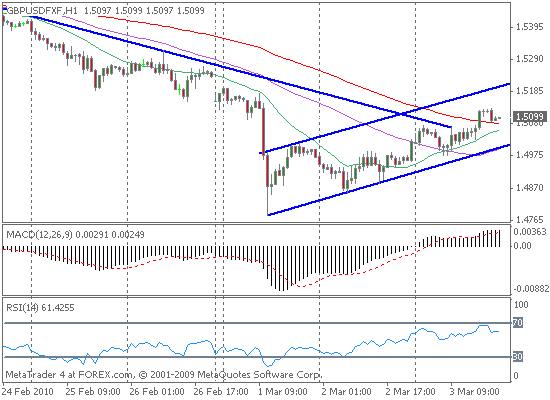By CountingPips.com
The U.S. Dollar has fallen versus its global currency rivals so far today in forex trading as investor’s risk appetite has hit renewed levels. The dollar has been losing ground versus the euro, British pound, Swiss franc, Australian dollar, Canadian dollar and Japanese yen while gaining ground against the New Zealand dollar, according currency data by Oanda at 3:47 pm EST.
 The euro has surged versus the dollar for the second straight day as the EUR/USD pair has extended to trading above the 1.3700 level. This pair touched a high of 1.3736 before pulling back and has traded at its highest exchange rate since February 17th. The euro has been helped out by news that Greece has pledged budget cuts and new taxes to help shore up some of its debt obligations.
The euro has surged versus the dollar for the second straight day as the EUR/USD pair has extended to trading above the 1.3700 level. This pair touched a high of 1.3736 before pulling back and has traded at its highest exchange rate since February 17th. The euro has been helped out by news that Greece has pledged budget cuts and new taxes to help shore up some of its debt obligations.
The U.S. stock markets, meanwhile, have traded a bit lower today after a positive start with the Dow Jones down by 3 points, the Nasdaq decreasing over 1 point and the S&P 500 at about even at the time of writing. Oil has climbed higher by $1.09 to trade at $80.77 while gold has gained by $5.80 to trade at the $1,142.70 per ounce level.
GBP/USD Chart – The British pound sterling has been gaining for a second consecutive day versus the American dollar as the GBP/USD has come off the 1.5000 psychological level to the upside to reach above 1.5100. The GBP/USD had fallen to a low point at 1.4784 on Monday due to concerns of a possible hung parliament emerging in the next election. This prompted speculation that a divided parliament could hamper Britain’s economic policy and growth.
U.S. Economic News: ADP Employment cuts 20k and ISM Service-Sector data rises
U.S. employment fell by 20,000 workers in January but marked the lowest monthly job decline in a year, according to the new ADP National Employment job report out today. U.S. nonfarm private employment fell by 20,000 workers in February following the revised decline of 60,000 jobs lost in January. The January jobs data was originally estimated to have fallen by 22,000 workers while February’s decline marks the 25th straight job declining month. Today’s data matched the 20,000 job decrease that market forecasters were expecting.
The employment data, despite the decrease, has improved in each of the last eleven months and today’s report marked the best monthly result since January of 2008 when the private sector added jobs.
The service-providing sector showed an increase of 17,000 jobs in February and increased for the second straight month. The goods-producing sector decreased by 37,000 jobs as construction jobs fell for the 37th straight month with a decline of 41,000 workers while the manufacturing sector had a gain of 3,000 jobs for the first rise since January 2008.
Medium sized businesses added jobs in February with an increase of 8,000 jobs. Large businesses lost 10,000 jobs in February and small businesses dropped 18,000 jobs.
The market-moving US Nonfarm Payrolls report for February is to be released Friday at 12:30 pm GMT with market forecasts predicting a decline of 30,000 jobs after January’s decrease of 20,000 jobs.
U.S. ISM Non-manufacturing Business expands
U.S. non-manufacturing business activity rose for the second straight month in February and increased to its highest level since December 2007, according to a report released today by the Institute for Supply Management.
The Non-manufacturing Index (NMI) registered a score of 53.0 percent in February from a score of 50.5 percent in January. Today’s data surpassed market forecasts which were expecting an index score of a 51.0 percent.
The NMI equally weights the index scores of business activity, new orders, supplier deliveries and employment and an index score below 50 is considered contracting or declining while a score above 50 is considered growth or expansion. Contributing positively to the report were increases in new orders, business activity/production, employment and supplier deliveries.
